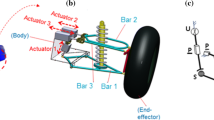Abstract
The research is carried out to improve passenger’s comfort to increase the vehicles stability in dynamic conditions. The literature available in the automotive engineering considers different topics for studying suspensions. An example represents mechanisms structure and analysis (synthesis, kinematics, and dynamics) under various operating conditions. These aspects have been approached before analytically, numerical. The current paper studies the influence of the lateral force on the contact patch of the wheel and the corresponding variations of vehicle stability parameters, such as camber angle and wheel rear track. The study is performed for a newer innovative rear suspensions mechanism which does not have a wheel track and camber angle variation, relative to the chassis, when the suspension components was considered rigid. A numerical solution is obtained through a virtual model on several commercial codes: MSC Adams, Patran, Nastran. Concerning the analysed parametes, their variation increases as the applied force is increased. Moreover, the largest variation corresponds to the case were elastic bushings and deformable links are considered.
Similar content being viewed by others
References
Alexandru, C. (2009). The kinematic optimization of the multi-link suspension mechanisms used for the rear axle of the motor vehicles. Proc. Romanian Academy, Series A 10, 3, 244–253.
Alexandru, C. and Alexandru, P. (2010). The virtual prototype of a mechatronic suspension system with active force control. WSEAS Trans. Systems 9, 9, 927–936.
Bastow, D. and Howard, G. (1993). Car Suspension and Handling. 3rd edn. Pentech Press. SAE.
Cambiaghi, D., Gadola, M., Vetturi, D. and Manzo L. (1996). Multi-link suspension analysis: An elastokinematic model. Proc. 29th ISATA Dedicated Conf. Simulation, Diagnosis and Virtual Reality in the Automotive Industry, Florence, Italy, 96VR031.
Dobre, G., Mateescu, V. and Ticã, M. (2010). On Double Wishbone front Suspension Mechanisms. Annals of DAAAM, 1332–1333, ISBN 978-3-901509-73-5, ISSN 1726-9679. Vienna, Austria.
Dobre, G., Mateescu, V., Ticã, M. and Miricã R. F. (2011). Study of car multi-link rear axle considering their Kinematic incompatibilities. Key Engineering Materials, 450, 316–319.
Ellis, J. R. (1989). Road Vehicle Dynamics. J. R. Ellis Publishing. Ohio.
Esfahani, M. I. M., Mosayebi, M., Pourshams, M. and Keshavarzi, A. (2010) Optimization of double wishbone suspension system with variable camber angle by hydraulic mechanism. World Academy of Science, Engineering and Technology, 61, 299–306.
Genta, G. and Morello, I. (2009a). The Automotive Chassis, 1: Components Design. Springer.
Genta, G. and Morello, I. (2009b). The Automotive Chassis, 2: Stystem Design. Springer.
Heuze, I., Ray, P., Gogu, G., Serra, I. and Andre, F. (2003) Design studies for a new suspension mechanism. Proc. Inst. Mech. Eng. Part D: J. Automobile Engineering, 217, 529–535.
Knapczyk, J. and Dzierzek, S. (1995). Displacement and force analysis of five-rod suspension with flexible joints. J. Mechanical Design 117, 4, 532–538.
Knapczyk, J. and Maniowski, M. (2006). Elastokinematic modeling and study of five-rod suspension with subframe. Mechanism and Machine Theory 41, 9, 1031–1047.
Laurent, D. and Sebe, M. (2001). Vehicle Suspension Having Active Camber Variation. Patent US 6,170, 838 B1.
Lukin, P., Gasparyants, V. and Rodionov, V. (1989). Automotive Chassis. Design and Calculations. MIR Publishers. Moscow.
Reimpell, J., Stoll, H. and Betzler, J. W. (2001). The Automotive Chassis: Engineering Principles. Butterworth/Heinemann. ISBN 0 7506 5054 0.
Reimpell, J. and Betzler, J. W. (2005). Fahrwerktechnik: Grundlagen. Vogel Buchverlag. Würzburg.
Rocca, E. and Russo, R. A (2002). Fesasibility study on elastokinematic parameter identification for a multilink suspension. Proc. Institution of Mechanical Engineers, Part D: J. Automobile Engineering 216, 2, 153–160.
Simionescu, P. A. and Beale, D. (2002). Synthesis and analysis of the five-link rear suspension system used in automobiles. Mechanism and Machine Theory 37, 9, 815–832.
Société, M. (2001). Véhicule automobile équipé d’un système de contrôle de l’angle de carrossage des roues en virage. Brevet Européen EP1070609, Brevet Japonais JP2001055034.
Ticã, M., Barbaraci, G., Dobre, G., Virzi-Mariotti, G. and Mateescu, V. (2011). Study of new automotive rear suspension mechanism. Balkan J. Mechanical Transmissions 1, 1, 68–72.
Zomotor, A. (1987). Fahrwerktechnik: Fahrverhalten. 2 Auflage. Vogel Buchverlag. Würzburg.
Author information
Authors and Affiliations
Corresponding author
Rights and permissions
About this article
Cite this article
Ticã, M., Dobre, G., Mateescu, V. et al. Influence of compliance for an elastokinematic model of a proposed rear suspension. Int.J Automot. Technol. 15, 885–891 (2014). https://doi.org/10.1007/s12239-014-0093-8
Received:
Revised:
Accepted:
Published:
Issue Date:
DOI: https://doi.org/10.1007/s12239-014-0093-8




